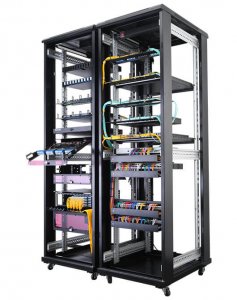Data centers are the backbone of modern technology and communication infrastructure. They house the servers, storage devices, and networking equipm
ent that keep our digital world running smoothly. Fiber optic cabling is an essential component of data centers, providing high-speed, reliable communication between devices and networks. In this article, we will discuss the specific applications of fiber optic cabling in data centers and the advantages it provides over other types of cabling.
Applications of Fiber Optic Cabling in Data Centers
- Data Transmission: Fiber optic cabling is widely used for data transmission in data centers. It can transmit large amounts of data over long distances, making it ideal for connecting devices within the data center or to remote locations.
- Network Backbone: Fiber optic cabling is often used as the backbone of data center networks. This cabling provides high-speed, reliable communication between switches, routers, and other networking devices, allowing data to be transmitted quickly and efficiently.
- Storage Area Network (SAN): A SAN is a high-speed network that provides direct access to data storage devices. Fiber optic cabling is often used to connect servers to storage devices in a SAN, allowing for fast and efficient data transfer.
- Interconnectivity: Fiber optic cabling is also used to interconnect different parts of the data center, such as racks, cabinets, and servers. This helps to ensure that data can be transmitted quickly and reliably between different parts of the data center.

Advantages of Fiber Optic Cabling in Data Centers
- High Speed: Fiber optic cabling provides high-speed data transmission, allowing data centers to handle increasing amounts of data traffic. This speed is essential for data centers that need to process large amounts of data in real-time.
- Reliability: Fiber optic cabling is highly reliable, providing a secure and stable connection for data transmission. This reliability is critical for data centers, where downtime can result in significant financial losses.
- Immunity to Electromagnetic Interference (EMI): Fiber optic cabling is immune to electromagnetic interference (EMI), making it ideal for use in data centers where EMI can cause problems for other types of cabling.
- Cost-Effective: Although fiber optic cabling can be more expensive than other types of cabling, it is cost-effective in the long run. This is because fiber optic cabling has a longer lifespan than other types of cabling and requires less maintenance, reducing the overall cost of ownership.
In conclusion, fiber optic cabling is an essential component of data centers, providing high-speed, reliable communication between devices and networks. With its many applications and advantages, fiber optic cabling is the preferred choice for data centers looking to improve their data transmission capabilities. Whether you’re building a new data center or upgrading an existing one, fiber optic cabling is a wise investment that will help you keep your data center running smoothly for years to come.
